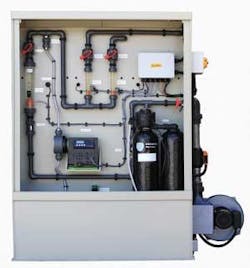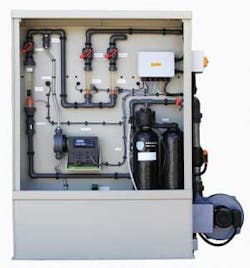System offers On-site Generation of Sodium Hypochlorite
By Harland R. Pond
For more than 75 years chlorine has been effectively used to disinfect drinking water, eliminating dangerous bacteria and toxic compounds. Water supply engineers and treatment facility operators are used to necessary risks and problems associated with chlorine disinfection in order to deliver safe water.
Typically three methods are used to apply chlorine:
- Chlorine gas dosing
- Dosing of sodium or calcium hypochlorite solution
- Electrolytic chlorine generation
These methods present a variety of risks and issues. Chlorine gas applications involve managing risks associated with accidental releases and contact with the dangerous gas. Dosing hypochlorite solutions require handling concentrated and dangerous chemicals, usually in bulk quantities. Beyond managing safety, operators often face operational issues such as off-gassing of liquids, degradation of the product, calcification when injecting and equipment failures. Managing these issues adds operational and capital costs for drinking water installations.
Treatment facilities often turn to sodium hypochlorite to deliver disinfection results and mitigate risks. One example of a new on-site sodium hypochlorite generation system is the Selcoperm system from Grundfos.
Electrolytic chlorine generation is an alternative method to apply sodium hypochlorite for disinfection, offering unique benefits for operations. Electrochlorination uses common raw materials – salt, water and electricity – to generate a low strength sodium hypochlorite solution (up to 0.8% concentration) on site. Installed generation equipment includes a brine storage tank, the actual electrogenerator and a final product solution tank from which the sodium hypochlorite is dosed.
Electrochlorination helps relieve operators of multiple concerns associated with other disinfection methods. Operators only store and handle common salt, eliminating the risks of handling dangerous chemicals. The final product, while still effective sodium hypochlorite, does not degrade as readily as stronger concentrations, allowing for on-demand service and reducing calcification of injection points. The generators also operate on demand, eliminating bulk storage of chemicals.
In electrolytic generation of chlorine, a brine solution is passed over a series of electrodes in an electrolytic cell. DC power is applied to the electrodes, resulting in the generation of sodium hypochlorite. Hydrogen gas is produced as a by-product, and must be safely managed.
This presents several issues with generating equipment. Often equipment is complicated and difficult to use or fix. Capital equipment and replacement parts are often expensive. And the generation of hydrogen gas requires special equipment to dilute and vent it to atmosphere to keep the concentration below 4% (the Lower Explosion Limit of LEL threshold). Most installations require special diluting equipment and explosion proof designs for the rooms to ensure safety. All equipment in this potentially explosive atmosphere must meet strict design requirements to prevent sparks. This adds installation and risk costs.
Grundfos has used focused engineering to design electrochlorination equipment that maximizes the value and reduces the risks for operators. The key to adding value in a water plant is to simplify engineering and controls while making the unit safe and reliable – all while keeping an eye on the total cost of operation.
The Selcoperm system design eliminates the need for explosion proof zones and equipment. The cells are vertical to ensure hydrogen freely leaves the unit and is vented through a degassing system that provides safe handling. The cell and degassing column are contained in a sealed enclosure with forced air ventilation to ensure any leaks stemming from poor maintenance or mechanical failure are diluted. Safety interlocks ensure the integrity of the system is maintained at all times. The system fails safe and cuts power to the cells in the event an unsafe condition is detected.
The system offers the safe and effective application of sodium hypochlorite while reducing total facility costs and risks compared to other technologies. This allows water treatment engineers and operators to focus on delivering clean, safe water for their communities. WW
About the Author:
Harland R. Pond is the North American disinfection product manager for Grundfos Pumps Corporation. For more information please contact him at [email protected] or visit us at www.grundfos.us/industry.

